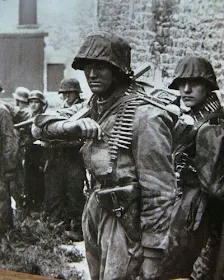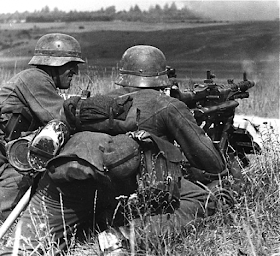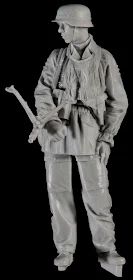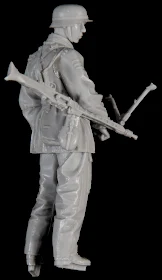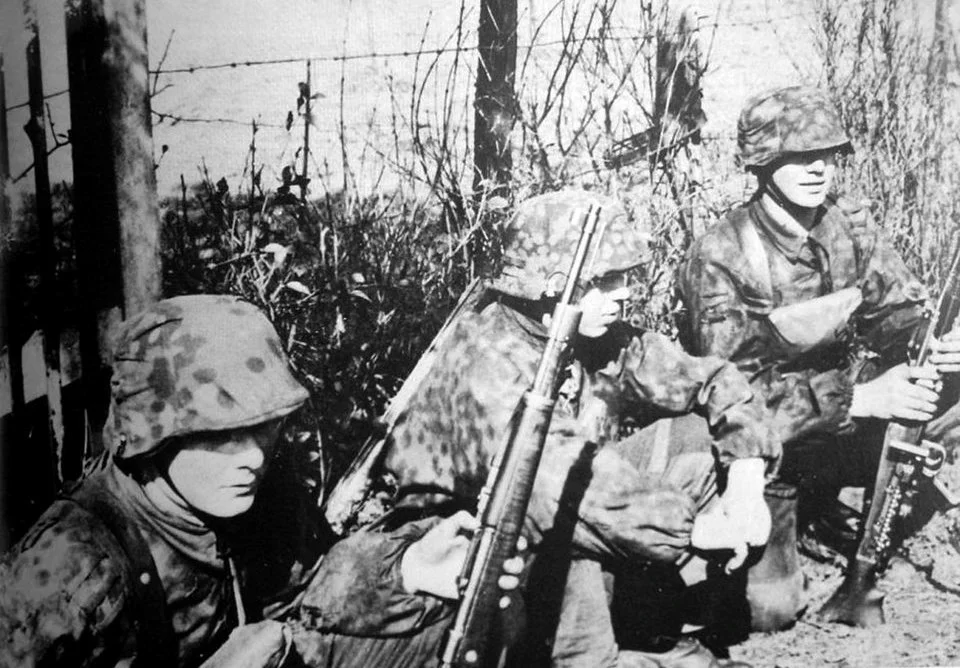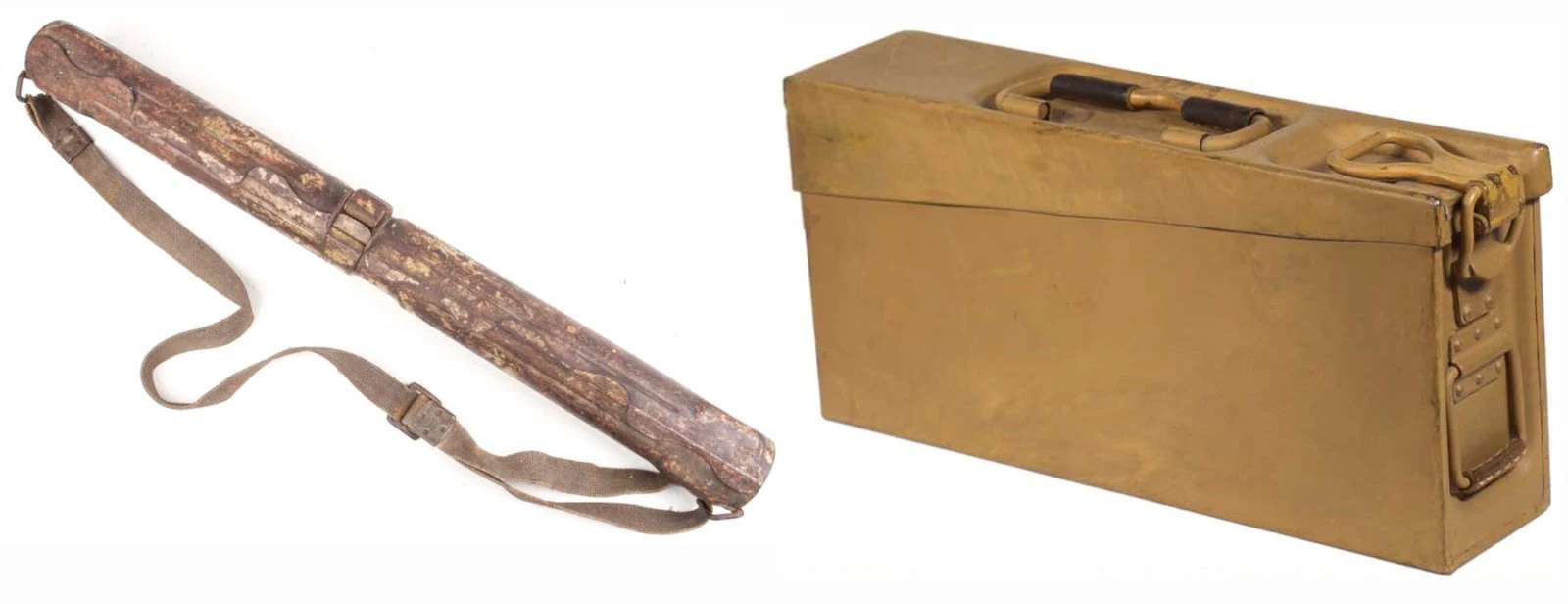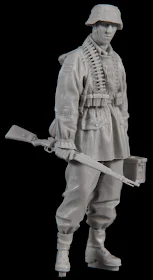Alpine Miniatures release of an assistant and a machine gunner in 1/35th scale “Hitlerjugend" is the focus of our review today. From the box art, both of them look every bit as tough as their reputation and hopefully as detailed as what we have come to expect from Alpine. See these two figures and the pictures that just might have inspired them in our preview...
Alpine Miniatures has two newly released figures for us this month. Both in 1/35th scale that represents a pair of soldiers from the 12th SS or Hitlerjugend (Hitler Youth) circa 1944. we have a little of a walk around of each of these figures, as well as a look at the men and in particular a soldier we think that these two are modelled on in this preview. First, a little on the 12th SS at this time of WWII.



This sculpt has the gunner's pouch and leather Walther pistol holster pinching the clothing, just like the picture of the assistant gunner below


 The Engineering of this figure / Putting him together:
The Engineering of this figure / Putting him together:
One or two things to note or that I discovered only after making this figure. He went together very fast, with no alteration on my end needed. I paused after I inserted the flask on to the bread basket on his rear and the spare barrel holder in place - both of them had notches for the gear to sit flush to the figure as they would in real life. The hand that glued to the ammo box went on the right-hand side of the top of the box when it was facing the same way as on the figure if you see by my picture below, it is slightly off to the right.
After this, the two hands went straight into the sockets provided by the sculptor, as did the head choices - hidden joints make these figures more realistic and easier to get looking just right.
MG Gunner 12 SS "HJ"
Construction Review: Two new 35th scale figures in three releases from the Hitlerjugend from Alpine Miniatures
MG Gunner 12 SS "HJ"
Kit No# 35266
1/35th scale
Sculpture by Taesung Harmms
Boxart by Jaume Ortiz Forns
Unpainted light grey resin figure
This figure comes with two head choices
Ammo Carrier 12 SS "HJ"
Kit No# 35267
1/35th scale
Sculpture by Taesung Harmms
Boxart by Jaume Ortiz Forns
Unpainted light grey resin figure
This figure comes with two head choices
MG Team 12 SS "HJ" Set
Kit No# 35268
1/35th scale
Sculpture by Taesung Harmms
Boxart by Jaume Ortiz Forns
Two unpainted light grey resin figures in one box
These figures both come with two head choices each.
The setting/ Timeframe these figures are taken from:
Waffen SS soldiers from the 12th SS Panzer Division “Hitlerjugend” were all conscripts from the ages of 15 to 18 years of age. They were thrown into battle in the action around Normandy during the D-Day landings from June 1944 onwards. These young soldiers were often fanatical in their fighting, and although they were young, they were well armed and well indoctrinated in the Nazi cause. This nationalistic zeal and some desperation of the situation they found themselves fighting in made them feared on the battlefield. The battle for Normandy took a large toll on the division and came out of the Falaise pocket with 12,000 men falling to the numerically superior allied invasion forces.
Waffen SS soldiers from the 12th SS Panzer Division “Hitlerjugend” were all conscripts from the ages of 15 to 18 years of age. They were thrown into battle in the action around Normandy during the D-Day landings from June 1944 onwards. These young soldiers were often fanatical in their fighting, and although they were young, they were well armed and well indoctrinated in the Nazi cause. This nationalistic zeal and some desperation of the situation they found themselves fighting in made them feared on the battlefield. The battle for Normandy took a large toll on the division and came out of the Falaise pocket with 12,000 men falling to the numerically superior allied invasion forces.
On D-Day, June 6th, 1944, the HJ Division was one of three Panzer divisions held in reserve by Hitler as the Allies stormed the beaches at Normandy beginning at dawn. At 2:30 in the afternoon, the HJ Division was released and sent to Caen, located not far inland from Sword and Juno beaches on which British and Canadian troops had landed. The division soon came under heavy strafing attacks from Allied fighter bombers, which delayed arrival there until 10 p.m. The Hitlerjugend were off to face an enemy that now had overwhelming air superiority and would soon have nearly unlimited artillery support. The Allies, for their part, were about to have their first encounter with Hitler's fanatical boy-soldiers.
The fanaticism and reckless bravery of the Hitler Youth in battle shocked the British and Canadians who fought them. If they were encircled or outnumbered, they fought-on until there were no survivors. Often when they did not surrender, young boys, years away from their first shave, had to be shot dead by Allied soldiers who were old enough, in some cases, to be their fathers. The "fearless, cruel, domineering" youth that Hitler had wanted had now come of age and arrived on the battlefield with utter contempt for danger and little regard for their own lives. This soon resulted in the near destruction of the entire division.
By the end of its first month in battle, 60 percent of the HJ Division was knocked out of action, with 20 percent killed and the rest wounded and missing. Divisional Commander Witt was killed by a direct hit on his headquarters from a British warship. Command then passed to Kurt Meyer, nicknamed 'Panzermeyer,' who at age 33, became the youngest divisional commander in the entire German armed forces.
By September 1944, the 12th SS-Panzer-Division Hitlerjugend numbered only 600 surviving young soldiers, with no tanks and no ammunition. Over 9,000 had been lost in Normandy and Falaise. The division continued to exist in name only for the duration of the war, as even younger (and still eager) volunteers were brought in along with a hodgepodge of conscripts. The division participated in the failed Battle of the Bulge (Ardennes Offensive) and was then sent to Hungary where it participated in the failed attempt to recapture Budapest. On May 8, 1945, numbering just 455 soldiers and one tank, the 12th SS-Panzer-Division Hitlerjugend surrendered to the American 7th Army.
The fanaticism and reckless bravery of the Hitler Youth in battle shocked the British and Canadians who fought them. If they were encircled or outnumbered, they fought-on until there were no survivors. Often when they did not surrender, young boys, years away from their first shave, had to be shot dead by Allied soldiers who were old enough, in some cases, to be their fathers. The "fearless, cruel, domineering" youth that Hitler had wanted had now come of age and arrived on the battlefield with utter contempt for danger and little regard for their own lives. This soon resulted in the near destruction of the entire division.
By the end of its first month in battle, 60 percent of the HJ Division was knocked out of action, with 20 percent killed and the rest wounded and missing. Divisional Commander Witt was killed by a direct hit on his headquarters from a British warship. Command then passed to Kurt Meyer, nicknamed 'Panzermeyer,' who at age 33, became the youngest divisional commander in the entire German armed forces.
Kurt Meyer at the time of the Battle of Normandy 1944 - note his Italian pattern camouflage jacket
After Caen fell to the British, the HJ Division was withdrawn from the Normandy Front. The once confident fresh-faced Nazi youths were now exhausted and filthy, a sight which "presented a picture of deep human misery" as described by Meyer.
An SS-Panzergrenadier in Normandy, 21 June 1944 - note his camouflaged smock and covered helmet similar to these soldiers from Alpine.
In August, the Germans mounted a big counter-offensive toward Avranches but were pushed back from the north by the British and Canadians, and by the Americans from the west, into the area around Falaise. Twenty four German divisions were trapped inside the Falaise Pocket with a narrow 20-mile gap existing as the sole avenue of escape. The HJ Division was sent to keep the northern edge of this gap open.
Dead German SS MG Gunner's assistant (note his spare barrel casing) Normandy 19th June 1944.
However, Allied air superiority and massive artillery barrages smashed the HJ as well as the Germans trapped inside the pocket. Over 5,000 armoured vehicles were destroyed, with 50,000 Germans captured, while 20,000 managed to escape, including the tattered remnants of the HJ.By September 1944, the 12th SS-Panzer-Division Hitlerjugend numbered only 600 surviving young soldiers, with no tanks and no ammunition. Over 9,000 had been lost in Normandy and Falaise. The division continued to exist in name only for the duration of the war, as even younger (and still eager) volunteers were brought in along with a hodgepodge of conscripts. The division participated in the failed Battle of the Bulge (Ardennes Offensive) and was then sent to Hungary where it participated in the failed attempt to recapture Budapest. On May 8, 1945, numbering just 455 soldiers and one tank, the 12th SS-Panzer-Division Hitlerjugend surrendered to the American 7th Army.
OK so that is the place and time - what about these figures?
Both of them come int he kiwi green little plastic box we know Alpine for, with two Zip-loc sealed bags. The single figures are of course sold by themselves - but these two are both in the one box with two headgear choices. Both of the figures are cast in light grey resin, and both feature no errors in casting or surface bubbles anywhere on them. The casting blocks that come with the torso's house all of the separate pieces we will look at later on, and they are joined at sensible places that are easy to remove from the parts you want.
Recreating German soldiers in 1/35th scale is a common theme for Alpine Miniatures, so it is something that has been well researched by the sculptor Taesung Harmms. Shown in the photo below is a 12th SS soldier captured after the Normandy landings at about the same time - probably only still a teenager, is very close to what inspired these shots one would think by his almost identical equipment and uniform.
He has the choice of two different headgear choices. One of these is the cloth camouflage covered M43 helmet with foliage loops. The boxart captures the second pattern cover, (Circa 1942-1945), with three panels of water-resistant, cotton duck construction, helmet cover with the machine roller printed, reversible, spring/autumn, Oak-Leaf "B", repeating splotch camouflage pattern. An earlier pattern lacking foliage loops was replaced in 1942 with a version that had loops like this one in the sculpt does. Instead of a drawstring, the cover was secured to the helmet with a series of steel or aluminium rocker clips. The version with the loops was by in large the most commonly worn cover by the Waffen-SS during the Normandy campaign. Both sides of the helmet cover reflected the seasons, It depends what time of the Normandy battle you would want your soldier to feature in.


Both of them come int he kiwi green little plastic box we know Alpine for, with two Zip-loc sealed bags. The single figures are of course sold by themselves - but these two are both in the one box with two headgear choices. Both of the figures are cast in light grey resin, and both feature no errors in casting or surface bubbles anywhere on them. The casting blocks that come with the torso's house all of the separate pieces we will look at later on, and they are joined at sensible places that are easy to remove from the parts you want.
MG Gunner 12 SS "HJ"
Kit No# 35266
1/35th scale
Sculpture by Taesung Harmms
Boxart by Jaume Ortiz Forns
Unpainted light grey resin figure
This figure comes with two head choices
Note the loops for attaching foliage on this second pattern model...


The other choice of headgear is the bare M43 helmet version with a simple rubber band around the sides of the helmet. This rubber was used to hold on to foliage, burlap or other materials to secure any sort fo camouflage to the soldier's helmet. Both of the head choices have the same face that has a strong resemblance to the soldier that this figure is based on - an SS Sturmmann. On the bare helmet rear, there is a slight resin seam that will need to be carefully removed.
The torso comes in a single part, with the right arm coming sperate and with the machine gun. The body of the soldier is covered in tunic and pants with the camouflaged SS pattern M42 Type 2 "Plane Tree" camouflage smock (Tarnjacke) over his regular tunic which sits on top of a roll neck jumper. The SS runes and rank can be clearly seen on his collar tabs, while at his neck hangs the camouflage face mask (gesichstarnmasken).

I HATE using photos of recreators but I found it hard to get photos of the gesichstarnmasken not covering the face and just worn on the chest like this modern-day re-enactor is below.
The soldier's tunic is the M42 "Plane Tree" camouflage smock (Tarnjacke) as introduced in late 1942. This pattern was almost identical to the earlier M42 Type 1 pattern with minor modifications to the pockets. Made from a waterproof cotton duck construction pullover smock with reversible, printed "Plane Tree" pattern camouflage. Camouflage pattern has distinctly different colourations to the summer and autumn sides, with the summer side being in shades of brown, tan and green and the autumn side in shades of browns and tans. Smock features a low, oval, boat style neckline with vertical lace-up front plaquet. You can see the pinching under the soldier's "Y" shaped braces and billowing of the thin cloth in the sculpt as it is pinched, trapped and loose on the torso and arms of the sculpt.
Attention to the smallest details that the eye is drawn to - like the hands - knuckles and fingers are what really sets this sculptor's figures apart...

The M42 first appeared in WWII photos during the battle at Kursk in July 1943 (in very small numbers.) By the Summer of 1944, they are the most prevalent pattern seen. The "M42" or "Type II" (both names being collector inventions) featured improvements over the earlier designs of Tarnjacken. The waistline was raised several inches with two cargo pockets placed just below it, and sets of loops were added around the shoulders to hold foliage. A real version of the reversible M42 Plane Tree camouflage smock (Tarnjacke) below,
When looking from the left of the sculpt you can see where the figure's missing right arm is attached, also the MG 42 gunners pouch in leather (as shown in the boxart - there is a composite version also). Do you notice the details on the leather straps, the pockets with buttons, belt, and the seams on the clothing, all looking very realistic in resin

This sculpt has the gunner's pouch and leather Walther pistol holster pinching the clothing, just like the picture of the assistant gunner below
Below the waist, you can see the Italian pattern "liberated" pants that were taken into the inventory after the surrender of their Axis ally are visible in the excellent box-top paintwork by Jaume Ortiz Forns. A bread bag hangs from the waist of the soldier's belt and as we will see later a water flask attaches there also. The boots, tucked under the trousers, are of the latter war ankle-height laced-up type.
A casting block that comes with this soldier houses the Maschinengewehr 42, or MG42 (minus the tripod mount that is on the other casting block) along with the arm of the gunner attached to it. You can see the wrinkling of the camouflaged tunic, and the three loops for vegetation to be attached to for natural cover.
The reverse side of the gun shapes up pretty nicely in proportions and detail to the original gun. Of course, the strap of the gun is included so there is one thing you do not have to scratch build or add to the figure. You can see the hollowed out part of the figure's arm that notches into the torso of the figure.

The base of the tripod mount is here, and as you can see it opened up, ready to be used. The soldier's right hand and water flask (and cup) are included here also.
The reverse of the block, with the fingers of the clenched but relaxed hand of the soldier evident, as well as the inside of the water flask.
The completed figure:
Only one or two real notes on making this figure. One - the separation points from the casting block make this easy to remove and prepare, and the second, I had a slight problem in fitting the right arm to the torso naturally without it seeming to leave a gap. I hollowed out a little on the inside of the arm to make the front and rear fit seamlessly. Just a little hollowing/ thinning out was needed to get the arm on there right.
The sculpt has good body language which really does match the photograph of him used as a reference by the sculptor and the way he is carrying his heavy MG 42 is well portrayed. This photo matches the figure very well here in this sculpt - not exactly the same clothing, but the body language and feel of the figure is very similar to this picture.
The completed figure:
Only one or two real notes on making this figure. One - the separation points from the casting block make this easy to remove and prepare, and the second, I had a slight problem in fitting the right arm to the torso naturally without it seeming to leave a gap. I hollowed out a little on the inside of the arm to make the front and rear fit seamlessly. Just a little hollowing/ thinning out was needed to get the arm on there right.
First, the figure with the bare helmet (with rubber band) choice option...
The other option - with the camouflage cloth-covered option is next...
Ammo Carrier 12 SS "HJ"
Kit No# 35267
1/35th scale
Sculpture by Taesung Harmms
Boxart by Jaume Ortiz Forns
Unpainted light grey resin figure
This figure comes with two head choices





Kit No# 35267
1/35th scale
Sculpture by Taesung Harmms
Boxart by Jaume Ortiz Forns
Unpainted light grey resin figure
This figure comes with two head choices
This soldier in the sculpt could well take some influence from the assistant gunner of the Machine Gunner in the photos below - this man's name was Otto Funk. He is seen in much the same clothing as his gunner in this well-known photograph which was titled "thousand-yard stare” and was taken around the same time in the Normandy area. Funk survived the war and died in September 2011. You can see Schuh in the background of this photograph.
This soldier has the choice of two helmets in the one boxing. Either a camouflaged cover cloth variant or the simple bare helmet with straps for securing local foliage or materials to the helmet. Although most of the SS soldiers had cloth covers by this part of the war and in this theatre, but some did not, and used this improvised way of holding camouflage on their helmets...



The camouflage cover on this soldier is of the same type as his partner, the machine gunner figure described above. You can see from the rear views below the attachment loops for the coth camo cover as well as the buckles of the bread bag on the bare helmet cover.


12th SS Hitler Youth 1944 maybe just outside Normandy - that same cloth-covered helmet is in evidence here.
The torso of this soldier is adorned in a similar fashion to his mate, but slightly differently and he carries some different equipment.
The soldier is wearing the same pants and camouflage smock as his partner on the machine gun. The same face mask that is draped over his chest. Below is are two NCO's from the "Deutschland" Regiment (denoted by the "1" on the collar tab on the right) wearing camo face veils on their chests over the camouflaged cover, and under that the soldier's regular tunic - you can see the SS runes on the collars poking out on the sculpt like the picture of these men below.
The nicely detailed MG bullet belt is draped over the neck of the sculpted figure with a hollowed space around each bullet looks great and adds depth to the detail here. Not only one, but sometimes several soldiers would bear the weight of all the ammo that this fast-firing light machine gun could spew out. You can also see at his waist the stamped steep buckled belt that the ammo pouches for his Kar.98 rifle fires, and on the rear right side of his belt is this soldier's bread bag.
This figure wears a blank look on his face, unlike the sculpt the soldier in the picture below left, who is smiling broadly. You can see he wears very much the same uniform and camo pattern and some of the trademark equipment. the SS collar tab is prominent in the phot as well as the sculpt. On the picture below left, a soldier of the SS carrying the Kar.98 with the ammo pouches on his belt as is the figure in the sculpt.
The separate casting block contains a water flask and cup, the soldier's shand with handle for the 200 round ammo box to feed the machine gun, and to be draped across his shoulders is the spare barrel carrier of the Mg 42, which is called the Laufschützer 42.
When firing the MG 34 and MG 42 continuously the German soldiers were presented with a harsh and difficult task: changing the barrel. The MG 34 and MG 42 where both made with a quick-change barrel and to help in the changing of the barrel. The barrel is then placed in the Laufschützer or barrel carrier to cool down and a cool new barrel is inserted. According to regulations, the barrel had to be changed after 150 rounds fired continuously. Every MG team had one or two spare barrels in spare barrel carriers with their field equipment. Also on the casting block is his flask and cup, with a flat, sagging cloth bread bag (with its strap off the body) are also attached to his back.


The other casting block houses a pretty good replica of the "soldier's bride" the Kar.98 rifle. This is carried in the soldier's hand, in this case already wrapped around the rifle for the most flush fit. Below is the real thing is for comparison.
One or two things to note or that I discovered only after making this figure. He went together very fast, with no alteration on my end needed. I paused after I inserted the flask on to the bread basket on his rear and the spare barrel holder in place - both of them had notches for the gear to sit flush to the figure as they would in real life. The hand that glued to the ammo box went on the right-hand side of the top of the box when it was facing the same way as on the figure if you see by my picture below, it is slightly off to the right.
After this, the two hands went straight into the sockets provided by the sculptor, as did the head choices - hidden joints make these figures more realistic and easier to get looking just right.
Note - the way the box is held, with the thinner end of the lid forward and the handle to the right-hand side of the lid...
The rifle and hand holding it went right in and to point slightly downwards as shown here.
The completed figure - fist (without the cloth headgear cover) and with a bread bag cloth straps...
The other headgear choice - with the cloth-covered helmet cover here this time...
MG Team 12 SS "HJ" Set
Kit No# 35268
1/35th scale
Sculpture by Taesung Harmms
Boxart by Jaume Ortiz Forns
Two unpainted light grey resin figures in one box
These figures both come with two head choices each.
Combining these two figures tells us not a lot more than what I have shown you through this review. They do come slightly cheaper as the set - but how do they match up to each other as a combo?
The box art picture for these two figures shows that although they are from the same unit and at the same time, the clothing and poses are different slightly enough to make a difference to each of them.
Though similar and different, they do complement each other in this sitting next to a tank, a muddy road, a wall, or some hedgerow in Normandy in mid-1944 - it is your choice - but shown here with several different combinations of headgear I can say they do match each other and make an interesting set - and kind of a trophy piece for especially SS soldier hunters in 35th scale as they can be attributed to a time, photos and place many of us have seen or heard about.
I think these are excellent in engineering, sculpting and casting and in general feel and body language. The gear is spot on and the poses as we saw in this review are very like the soldiers of this time. An excellent set from Alpine who kee that bar raised for everyone else to strive to.
Adam Norenberg
The box art picture for these two figures shows that although they are from the same unit and at the same time, the clothing and poses are different slightly enough to make a difference to each of them.
Though similar and different, they do complement each other in this sitting next to a tank, a muddy road, a wall, or some hedgerow in Normandy in mid-1944 - it is your choice - but shown here with several different combinations of headgear I can say they do match each other and make an interesting set - and kind of a trophy piece for especially SS soldier hunters in 35th scale as they can be attributed to a time, photos and place many of us have seen or heard about.
I think these are excellent in engineering, sculpting and casting and in general feel and body language. The gear is spot on and the poses as we saw in this review are very like the soldiers of this time. An excellent set from Alpine who kee that bar raised for everyone else to strive to.
Adam Norenberg
These two figures are sure to be popular with modellers, they are available now through the Alpine Miniatures Website…
We thought instead of just seeing both fo these figure unpainted by us, you might like to see also them painted up by the hands of a master, in this case, Jaume Ortiz Forns, who made these and the box art for the kit...
MG Gunner 12 SS "HJ"
Kit No# 35266
1/35th scale
Sculpture by Taesung Harmms
Boxart by Jaume Ortiz Forns
Unpainted light grey resin figure
This figure comes with two head choices
Ammo Carrier 12 SS "HJ"
Kit No# 35267
1/35th scale
Sculpture by Taesung Harmms
Boxart by Jaume Ortiz Forns
Unpainted light grey resin figure
This figure comes with two head choices
MG Team 12 SS "HJ" Set
Kit No# 35268
1/35th scale
Sculpture by Taesung Harmms
Boxart by Jaume Ortiz Forns
Two unpainted light grey resin figures in one box
These figures both come with two head choices each.








